30 October 2023
![]() 24 mins Read
24 mins Read
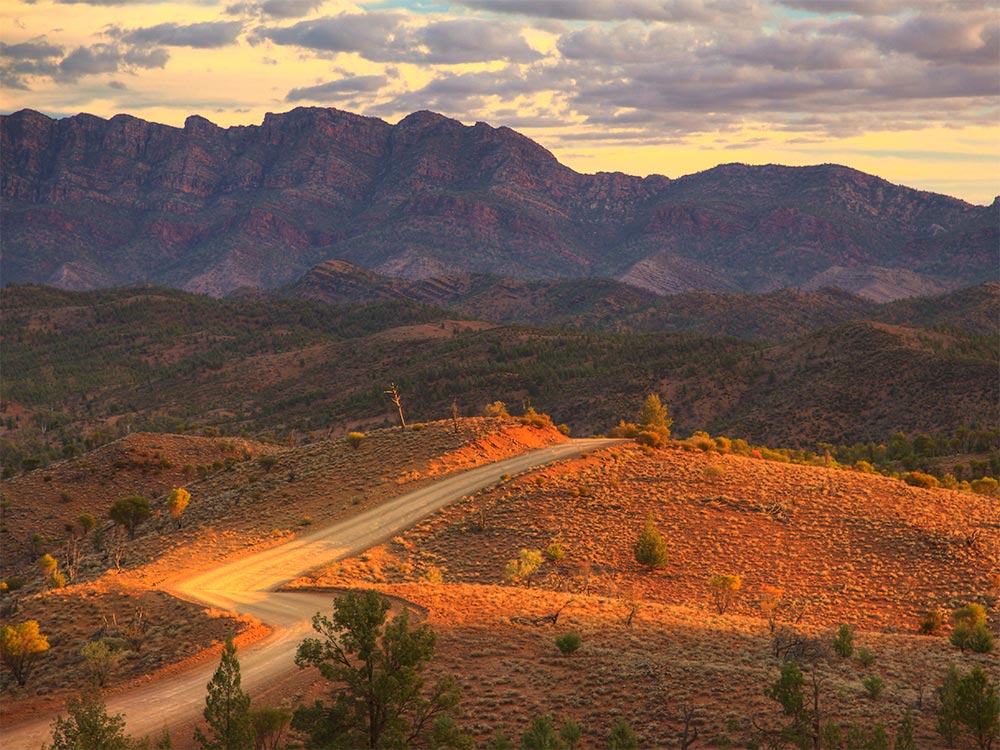
Part of the appeal of visiting rural and remote Australia is the eccentric characters and vast, idyllic landscapes you find there, but both are suffering under the weight of drought.
Rain continues to elude many parts of the country, which means your tourism dollars can go a long way in injecting some much needed money into some of our most vulnerable communities. If you need some inspiration, take some from our special 100 ways to holiday here this year hub, which we created in partnership with Tourism Australia. Here are 14 trips that featured in the top 100 to take in support of drought-affected communities.
Larapinta Trail, NT: Tracing the ridges of the West MacDonnell Ranges over 223 kilometres from Alice Springs to Mt Sonder, the legendary long-distance Larapinta Trail winds through the Northern Territory’s ancient desert landscape. To complete the whole track you’ll need up to 20 days, but you can choose to walk sections or tag along with several operators including Australian Walking Holidays and Life’s an Adventure, which offer guided experiences condensed into under a week.
Carnarvon National Park, Qld: Covering off a raft of different topographies including rainforest, mountainside and sandstone gorges, Carnarvon Gorge and the Wild West is an eight-day guided walk with Auswalk that ventures into the heart of the Queensland outback and Carnarvon Gorge. You’ll stay in comfortable en suite chalets, cabins and glampsites along the way.
Flinders Ranges, SA: The 1200-kilometre Heysen Trailcomprehensively covers South Australia’s diverse landscapes – including its epic outback. Head to the Flinders Ranges to hike sections of the trail. Australian Walking Holidays offers a six-day Heysen Trail and the Flinders Ranges tour as well as Wild Bush Luxury’s four-day Arkaba Walk, one of the Great Walks of Australia.
Kimberley Walking Tour, WA: Take on the majesty of the remote East Kimberley region and sleep under the stars in a swag with Park Trek’s 10-day walking and camping tour. Starting and ending in Kununurraand with 4WD transport to cover off some of the less foot-friendly distances. You’ll also stop at paradisiacal swimming spots along the way, including the warm pools of Zebedee Springs, and stay on the famous El Questro station.
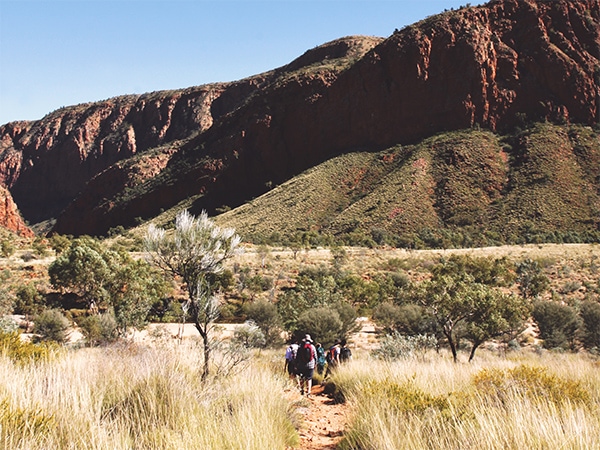
Set out on a multi-day outback hike.
Drought is something we are used to in this wide brown land of ours, but many of us are often removed from the impact of it. One way to better understand what life on the land is like, and help out even for a few days, is by booking a station stay at one of the many working cattle stations that form a patchwork across the country.
Places like Trilby Station, a roughly 130,000-hectare property near the village of Louth in outback NSW, owned and run by Liz and Gary Murray. Or the organically farmed Kilcowera Station, a 38,000-hectare property halfway along the Dowling Track in Queensland. Or Moolooloo and Moorillah Station in the heart of South Australia’s Flinders Ranges; the merino sheep station has been in the Slade family for four generations.
Station stay accommodation options can be anything from campsites to shearer’s quarters to bunkhouses, with hearty meals often included. As for what to do when you are settled in, the activities run the gamut from outback hikes, yabbying and fishing, birdwatching and four wheel driving.
But possibly the most rewarding pastime is helping out with the day-to-day chores and jobs required to keep outback stations running smoothly. To find out more about station stays across the country, check out the options on Outback Beds, Station Stays SA and Outback Queensland.
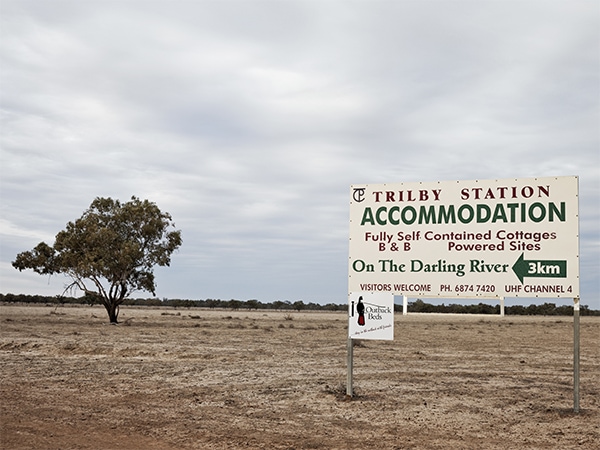
Stay on an outback station (Credit Destination NSW).
The seaside city of Geraldton on Western Australia’s Coral Coast supports a proud Indigenous culture and the Yamaji Drive Trail is testament to this. Looping together 14 sites of significance to local Aboriginal communities, the 195-kilometre trail takes in natural beauty, art and history and can be driven in one to two days at leisure, beginning at Champion Bay (Jambinu).
From the historic town of Greenough, amble along the Greenough River Nature Walk Trailand visit freshwater Bootenal Spring, believed to be the site of confrontations between local Aboriginal people and early settlers. Then head east to Ellendale Pool, a waterhole and campground that makes for a dreamy swimming and overnight spot; encased by giant gums and a rocky gorge, the site is watched over by Bimarra the Serpent.
Continue east to the wildflower town of Mullewa and the red-dirt landscapes of the lower Murchison; the tour ends at Butterabby Graves site, a place of conflict between First Nations people and pastoralists. Visit Geraldton Visitor Centre to pick up a trail map.
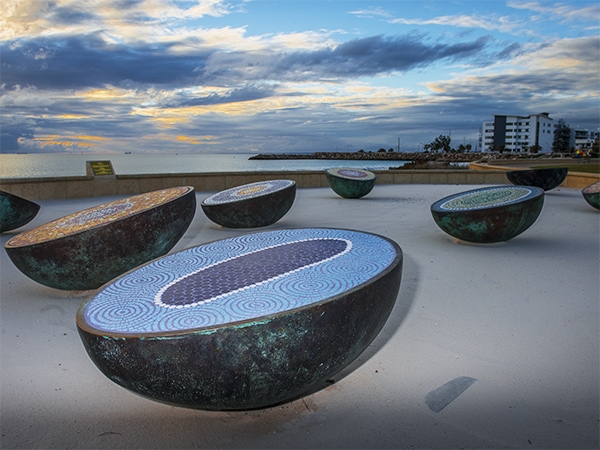
Do Geraldton’s Yamaji Drive Trail.
In 2016, the Flinders Ranges National Park was officially renamed Ikara-Flinders Ranges National Park to incorporate the traditional name, meaning ‘meeting place’, of its star attraction, Wilpena Pound. And with the only accommodation within the park, Wilpena Pound Resort, under the aegis of the traditional Adnyamathanha owners, you’re all but guaranteed an authentic immersion here.
Take part in any number of its Aboriginal Cultural Tours, from a Yura Udnyu stroll to Old Wilpena Station to a guided cultural walk to Sacred Canyon to see ancient rock engravings. And take a self-guided scenic drive to Arkaroo Rock– a particularly important Aboriginal art site in the Flinders Ranges featuring ochre and charcoal images depicting the creation of Wilpena Pound.
Some 200 kilometres north-east of here lies Vulkathunha-Gammon Ranges National Park. The spectacular terrain of this Northern Flinders Ranges park is crowned by a vast salt lake, Lake Frome – or Munda – which plays an important role in the lives of the Adnyamathanha people.
Hiking trails will take you deep into the heart of the rugged landscape, but your best bet is to sign up for a journey with Indigenous owned and operated Iga Warta, which has a range of tours and activities that shine a light on Adnyamathanha culture and the rules for living from the Muda (Dreaming).
St Mary Peak, the highest summit in the Flinders Ranges, is central to the Adnyamathanha creation story, as Uluru is to Anangu. And while its circuit trail is part of the popular Wilpena Pound circuit, its traditional owners prefer that visitors don’t climb the summit and advise stopping at Tanderra Saddle.
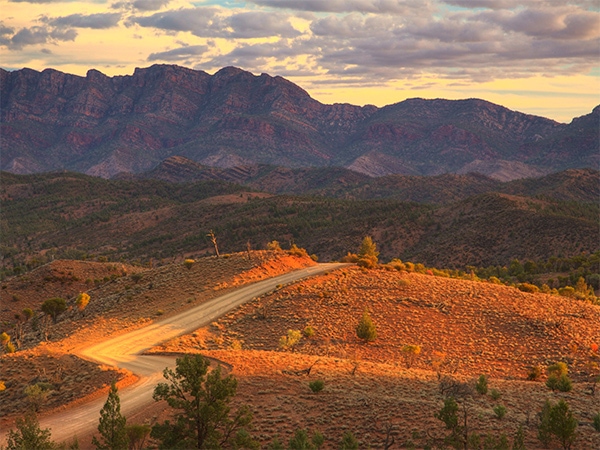
Explore the Flinders Ranges from a traditional perspective.
Located in the NSW Central Tablelands, less than three hours’ drive from Sydney, Bathursthas much more to recommend it than just fast cars.
The historic Begonia House, located in the pretty surrounds of Machattie Park in the heart of town, is filled with a stunning show of flowers that are a joy to behold.
The Australian Fossil and Mineral Museum houses the internationally celebrated Somerville Collection, including a complete Tyrannosaurus rex skeleton.
Bathurst is filled with stunning heritage buildings, many of which you can experience at close quarters: book a stay at Alfred on Keppel, a lovingly restored heritage terrace house; tour Abercrombie House, built in the 1870s; and visit Chifley House, the former home of Australian Prime Minister Ben Chifley and his wife Elizabeth, left as the couple would have known it in the 1940s.
Drive through stunning countryside to reach the nearby gold rush towns of Hill End and Sofala; explore the impressive Abercrombie Caves Nature Reserve; and take the walking track to Grove Creek Falls.

Escape to the country in Bathurst.
With more than 185 heritage-listed buildings, a characterful old train station that’s now a museum and the picturesque Avon River running right through it, Western Australia’s largest inland town, Northam, already had a lot to recommend a visit.
But the transformation of eight 38-metre-high grain silos into giant works of art in 2015 not only heralded Australia’s first silo mural and marked the start of a self-guided art trail that runs across the Wheatbelt, it had an energising effect on the town itself.
In 2018, Northam saw the opening of the Bilya Koort Boodja Centre for Nyoongar Culture and Environmental Knowledge, an architect-designed hub that celebrates the rich Aboriginal and environmental presence in the region.
And now, the town welcomes the complete revitalisation of the Farmer’s Home Hotel – a 190-year-old property that evolved from a wattle and daub hut into one of the most distinguished Federation hotels in regional WA.
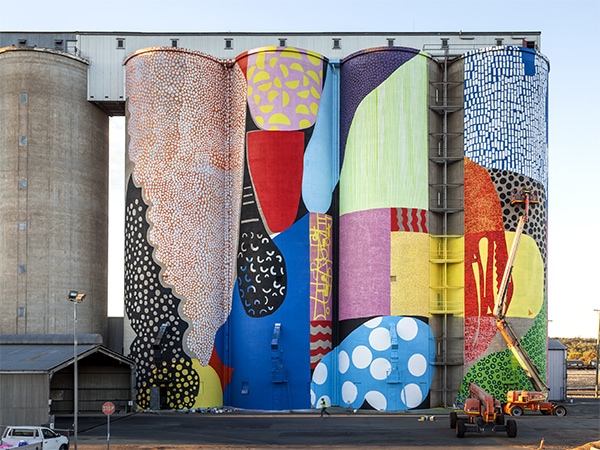
Discover old-school charm and new ideas in Northam (Credit Bewley Shaylor).
Rising up to 1200 metres above sea level, Queensland’s Granite Belt region is home to some of Australia’s most dramatic scenery and offers surprises at every turn of the New England Highway between Stanthorpe and Tenterfield. Here, some absolute highlights of the southern end around Ballandean.
With its 11,800 hilly hectares of unique rock formations and hiking trails, Girraween National Park and neighbouring Sundown National Park offer some of the most rewarding walking locations. An alternative for a walk to see spectacular balancing boulders is at Bald Rock National Park adjoining Girraween, accessible from the NSW side of Tenterfield (entry fee applies). Here you’ll find the largest exposed granite rock in the southern hemisphere.
Close to Girraween at Wyberba there’s a small cluster of wineries. David and Lori Broadbent offer a range of reds and whites including a highly awarded reserve sagrantino at Balancing Rock Wines. Pyramids Road Wines focuses on low-volume handmade wines with a big range of grape varieties, with reds like mourvèdre and petit verdot prominent. Girraween Estate have won top awards for their shiraz cabernet and chardonnay. And they also produce fruit-driven, crisp and refreshing sparkling wines.
It’s not just about the wines of the Granite Belt. You’re very welcome to rock up to a brewery or distillery if that’s more your fancy: there are several choices including the boutique Brass Monkey Brew House, the closest to Ballandean; Granite Belt Brewery (with pub-style food, and comfortable cabin accommodation so you don’t need to drive).
Not far from Castle Glen you’ll find a spot called Donnelly’s Castle. You can squeeze through crevices in giant granite rock boulders, walk on top of them and enter into cave-like openings. The famed bushranger Captain Thunderbolt once used this rocky outcrop north of Stanthorpe as his hideout and it’s a hidden gem.
Now it’s time to pack your Esky full of the region’s fresh organic food and artisanal, hand-crafted products including, Sutton’s Juice Factory for natural juices and handmade apple pies; Ashbern Farms for strawberry picking and ice-cream; Stanthorpe Cheese for a great selection to accompany your wine purchases; Mt Stirling Olives for fruity, cold-pressed extra virgin oils; Jamworks Gourmet Foods for jams and relishes made from local produce; Anna’s Candles for soy-based scents; and Washpool Farm Soaperie for natural products and soap-making workshops.
Accommodation options include the Girraween Environmental Lodge, Wisteria Cottage and Girraween Country Inn.
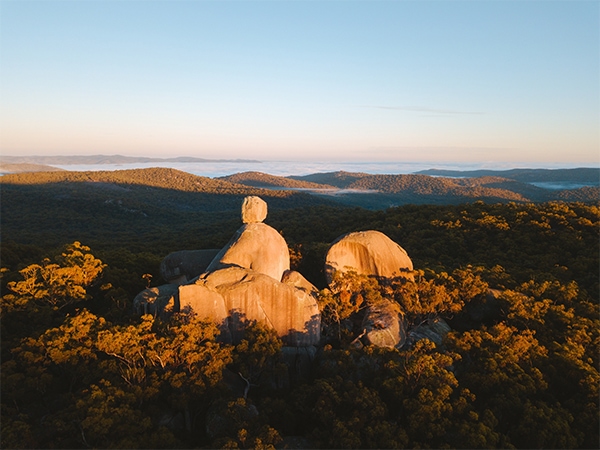
Rock on in the Granite Belt (Credit Tourism and Events Queensland).
The Central West city of Orange has many attributes: a boutique wine region, a long-established reputation as the food bowl of NSW, elegant Edwardian architecture and deciduous trees with riotous autumn leaves; it’s also the birthplace of Banjo Paterson. But now, an influx of tree changers and returning residents have also shaken up the city’s hospitality landscape, redefining Orange as a foodie destination not to be missed.
We don’t make it to Orange’s two hatted restaurants, Lolli Redini and Charred Kitchen & Bar, but instead, make a beeline for the newly opened The Arthouse Bar & Courtyard and Schoolhouse Restaurant in the historic Union Bank building. The restaurant showcases Orange region produce in a simple and vibrant way through a brasserie-style menu with nods to the Mediterranean.
Just out of town at Borrodell Vineyard, a lofty 1000 metres above sea level and also a cherry, plum and heritage apple orchard and trufferie, Sister’s Rock Restaurant is also elevating the local dining experience and is more than deserving of a stop on your itinerary.
Orange’s world-class cool-climate wine industry was first cultivated almost 40 years ago by a handful of innovators, including the names behind Canobolas-Smith, Bloodwood Wines, and Philip Shaw Wines; the cellar doors of which you can still visit today.
Nashdale Lane’s cellar door (and glampsite) is a 10-minute drive from the centre of Orange and well worth a visit for a tasting of its vibrant collection of award-winning, single-vineyard wines. A few kilometres further west of Orange, Heifer Station Wines runs its cellar door out of an old woolshed. It’s a proud family business and one that plays a big role in the local community. For four years it has hosted an annual drought-relief lunch, Feast for Farmers, and the morning of our visit is the night after Cold Chisel played A Day on the Green here on the property.
If there’s one place that epitomises all facets of Orange’s new energy, it’s Byng Street Boutique Hotel – a historic homestead that has been transformed into a 4.5-star hotel. Of its 22 guest rooms and suites, three are in the heritage wing. The rest are part of the hotel’s modern wing, which has been juxtaposed onto the back of the house with strong lines, light-filled spaces peppered with local artwork, and a pop artist’s palette.
Byng Street doesn’t fall short in the culinary department either. A two-course, à la carte breakfast showcasing fresh local produce is served in the Yallungah Dining Room.
Add these to your itinerary too: Ferment The Orange Wine Centre & Store is a wine bar and cellar door that is a perfect intro to the region’s offerings; Good Eddy is a hip cafe joined by a boutique and florist to form a cool retail hub called The Collective; The Sonic is a concept store that combines fashion, homewares and coffee.
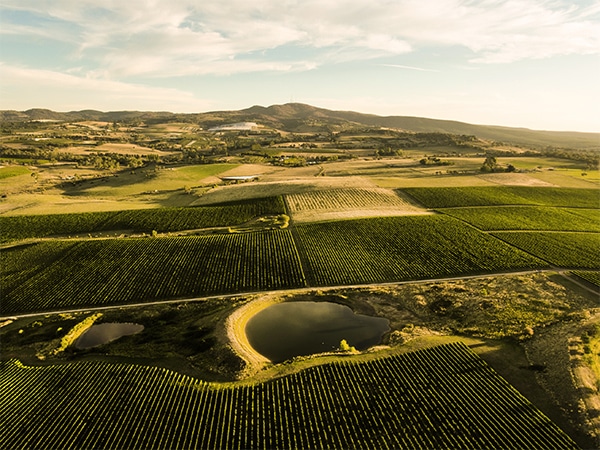
Sample the dynamic food and wine scene in Orange.
The traditional country of the Yugambeh people, with World Heritage-listed rainforest and six national parks spread over an area of some 4000 square kilometres, driving Queensland’s Scenic Rim offers up scenery and surprises aplenty.
Start the journey by driving just over an hour from Brisbane to the small village of Harrisville to arrive at Summer Land Camel Farm. It’s the largest commercial camel farm outside of the Middle East, with more than 550 animals, many having been ‘rescued’ from Central Australia and brought here to breed and produce nutritious, organic dairy products: milk, yoghurt, cheese – including a wonderful Persian feta – and a highly awarded skincare range.
If it’s sheep cheese you prefer, your next stop should be Towri Sheep Cheesery in Allenview. Here Carolyn and Dallas Davidson will proudly introduce you to their 350 specially bred sheep and the award-winning hand-crafted cheeses.
After all that cheese you’ll be in the mood for a few tempting vintages. The Scenic Rim is renowned for its prize-winning wineries where you’ll find a variety of styles, including some excellent fortified wines; the port at Bunjurgen Estate is particularly moreish.
Meanwhile, Scenic Rim Brewery at Mt Alford specialises in liquid of an amber hue. Try crafty brews combined with a homemade deli takeaway lunch that can be enjoyed at a scenic picnic spot nearby.
Talented chefs here are passionately embracing the area’s abundance of farm-fresh veggies, meats, relishes, jams and of course, the dairy products. Two of the best are Daniel Groneberg, who runs the kitchen at Kooroomba; and Richard Ousby, who is a recent arrival at The Overflow Estate 1895’s pretty lakefront cafe. Be sure to sample the fruits of their labour while in town.
Food and wine are fine, but the real joy of a Scenic Rim visit is the magnificent countryside. From sedate, well-marked tracks, to challenging mountain scrambles, try these on for size:
Lower Portals Track (7.4 kilometres/three hours);
Mee-Bor-Rum Circuit (720 metres/15 minutes);
Mt Edwards Summit Trail (six kilometres/3.5 hours);
Rainforest Circuit (1.6 kilometres/30 minutes) and Mt Cordeaux Track (6.8 kilometres/2.5 hours);
Palm Grove Circuit (2.7 kilometres/one hour);
Curtis Falls Track (1.1 kilometres/30 minutes);
Witches Falls Circuit (3.6 kilometres/one hour);
and Moran Falls (4.4 kilometres/1.5 hours).
The Scenic Rim brims with stylish locations to rest your head after a long day of indulging: Spicers Peak Lodge boasts top-class cuisine; O’Reilly’s Rainforest Retreat for great activities and walks; or Nightfall Camp for a unique luxury glamping experience.
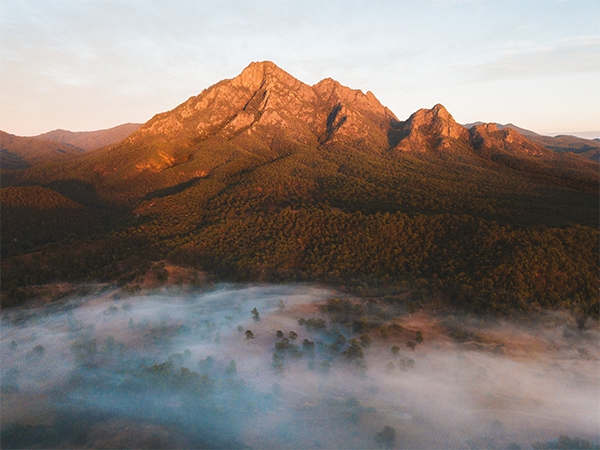
Unearth the surprises of the Scenic Rim.
The Yass Valley presents the perfect long weekend escape to the country, complete with quaint towns, impressive cellar doors and quality cafes and restaurants using the abundant local produce. Here, the ideal itinerary.
The three-hour drive south-west from Sydney, through the stunning scenery of the Southern Tablelands, delivers you to the town of Yass, once the hub of all things sheep related.
After strolling past former bank buildings, the imposing post office complete with clock tower and elegant courthouse, head to the interesting local collective of Trader & Co. for lunch and seriously good coffee courtesy of socially conscious locals Six8 Coffee Roasters.
Next, duck into Banjo Paterson Park and then pay a visit to Cooma Cottage – the home of another famous local, the Australian-born explorer Hamilton Hume.
And be sure to pick up some baked goods along the way from Clementine Bakery, the new project from the team behind Clementine Restaurant.
The landscape surrounding the town of Murrumbateman, a 20-minute drive from Yass, is home to some of the region’s best cold-climate wineries. Park the car and use pedal power to navigate your way from one to the other down quiet country roads.
Standouts include: Shaw Wines, The Vintner’s Daughter, Clonakilla; and Murrumbateman Winery. Most offer cheese and share plates to accompany wine tastings. Swing by Robyn Rowe Chocolates to grab some hand-crafted treats to enjoy later with your cellar door purchases.
Yass isn’t the only town worth attention in these parts. Nearby Binalong, the childhood home of Banjo Paterson, also has ties to bushrangers such as Ben Hall; a mural in Pioneer Park recounting the death of bushranger ‘Flash’ Johnny Gilbert at the hands of the police, and there’s some impressive period architecture.
Twenty minutes away is Bowning, one of the area’s earliest settlements; check out the Cobb & Co. Coaching Station, Troopers Cottage and the Bowning Hotel, a quintessential Aussie pub where local legend has it, Henry Lawson and Banjo Paterson used to drink.
Wallaroo is home to a number of wineries – the Hills of Hall wine sub-region centred here is likened to Tuscany – while nearby Gundaroo boasts the award-winning Grazing restaurant.
The accommodation offering in Yass is just as impressive, including the design-driven Abode Murrumbateman; Tallagandra Hill Winery has three self-contained, stylishly decorated cottages to choose from; and Yass Tiny Farm and Accommodation has two eco-friendly, off-grid options.
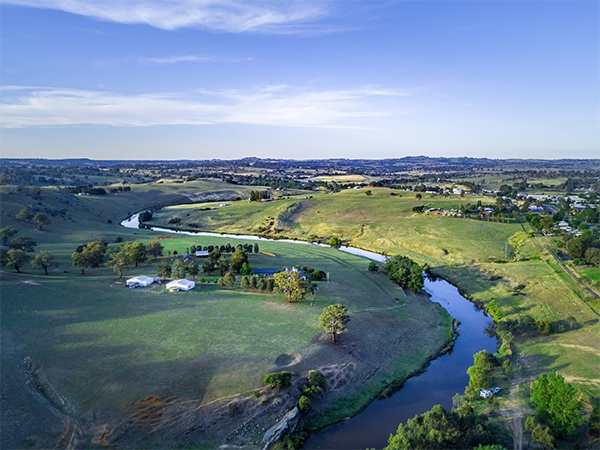
Road trip through the Yass Valley.
Mudgee might just be the perfect country town – a place that balances old-school charm with plenty to satisfy the 21st-century palate. The NSW town is surrounded by rolling hills studded with vineyards that serve epicurean fare alongside their award-winning drops.
To get a taste of everything, time your visit to coincide with Mudgee Farmers’ Market on the third Saturday of every month or the Mudgee Wine + Food Festival in spring. Or go on a Mudgee Farm Walk, where you’ll join a guided visit to two farms (different each month) to engage with their farmers and be part of a real paddock-to-plate journey.
Or simply swing by any cafe or restaurant in town or surrounds and let the goods come to you: our picks are Alby & Esthers, tucked away in a gorgeous courtyard off Mudgee’s main drag; Roth’s Wine Bar, which has been serving up food, wine and music for almost a century; elegant Zin House on the organic and biodynamic Lowe Wines property; and unique fine diner Pipeclay Pumphouse at Robert Stein Winery.
Poke your nose around the plethora of other pretty country towns in the region, each distinctive in its own right. Starting with Rylstone, this sandstone-hewn heritage town and its surrounds are known for their olive estates and wineries. An extension of the Mudgee wine region, the town hosts Street Feast, with its popular long table lunch, each year. There’s also handmade dumplings to be had at 29 Nine 99 and good coffee at places like The Saffron Kitchen & Cafe.
In between, squeeze in the scenic drive from Rylstone to Mudgee to visit the village of Lue and its local icon of a pub, the Lue Hotel – serving cold beers since 1912. Thirty kilometres north of Mudgee, Gulgong is a former gold mining town that feels like a time capsule back to the 19th century.
You can even visit the oldest still-operating opera house in the southern hemisphere: the Prince of Wales Opera House opened in 1871 and in its heyday saw the great Dame Nellie Melba grace its stage. The town and surrounds are a haven for ceramicists and artists, and an international clay festival is held here every two years.

Hit the road to Mudgee (Credit Lowe Wines).
From our clifftop perch, pale blue skies and ochre dirt collide. Forty metres below, bands of gum trees push through a sea of mist to reflect in the still mirror of snaking water. Next to me, my 80-year-old mother’s face beams in the burnt-butter light cast by the rising sun. Vast and timeless, the land seems to act as a spirit level, emanating peace and creating a space for shared wonder.
Our second morning on the Murray River Walk is hypnotically beautiful. The day before, our wanderings had taken us over trackless bushland where emus and kangaroos watched from a distance, and winding oxbows lay scattered with pelicans, egrets and herons. We’ll walk 40 kilometres over four days and cruise 70 kilometres along a stretch of river upstream from Renmark in South Australia, close to the Victorian border.
Home is a houseboat, a modern and cosy two-tiered vessel with five cabins, lounge and rooftop spa that we share with eight other guests and three crew. My mother’s desire to connect with a quintessential piece of Australia has brought us here, on our first holiday together since I was a teenager.
Here, the water snakes and curls as it meanders across floodplains and, as water levels vary, so does the walk. There are no tracks or trail markers to follow here; we are far from civilisation. Our guide leads us on animal trails and routes of her own choosing, skirting the river’s edge under the watchful eyes of whistling kites, pelicans and yellow rosellas twittering in the treetops. I enjoy discovering the river on foot but the views seem somehow sweeter from the hot tub on the houseboat’s top deck.
Walking days are leisurely, finishing mid-afternoon before slipping into a hedonistic evening of nibbles and three-course dinners paired with bottomless local wines. Internationally acclaimed chef Andrew Fielke, a specialist in the use of native ingredients, is the master behind the menu.
Food is plucked from the surrounding riverland: yabby bisque, Murray cod with lemon myrtle crust and kangaroo osso buco. Wilted buds of saltbush, picked during our rambles, are mixed with the morning’s scrambled eggs. We are not just walking the land, we are tasting it, too.
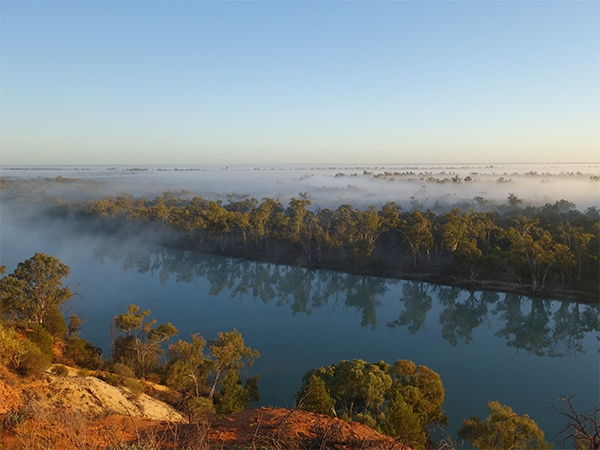
Go houseboat hiking on the Murray River (Credit Laura Waters).
South Australia’s Eyre Peninsula is something of a natural wonderland with untold amounts of outdoor adventure to be had. Anchoring yourself around Port Lincoln on the Lower Eyre Peninsula will provide an ideal overview and offer up a whole raft of kid-friendly accommodation options.
Spend a day in the water with Adventure Bay Charters or Calypso Star Charters (both eco-certified) to get up close to a great white shark in its natural habitat or swim with sea lions, adorably known as puppy dogs of the sea.
Spend another day in nearbyLincoln National Park for its myriad boating, fishing, beachcombing, whale-watching and nature walk opportunities. Hole yourself up on family-friendly Stamford Beach for a while for some beach cricket and safe swimming.
Also in the area, Mikkira Station is a restored homestead (circa 1842) that is these days home to a colony of wild koalas.It’s also a lovely spot for a picnic and a bushwalk, too.
Similarly, Glen Forest Tourist Park is a wildlife haven with baby animals on tap for feeding and cuddling, plus mini-golf, Segway rides and a whole host of creatures to spot in the 50-hectare animal park. There’s also a vineyard on site, so take away a couple of bottles of shiraz or sauvignon blanc for after hours.
Also on the Eyre Peninsula: go swimming at some of South Australia’s loveliest beaches in Coffin Bay National Park. Hire a boat from EP Boat Hire to sail around beautiful Coffin Bay. Swim with dolphins and sea lions at Baird Bay on the west coast. Take a fascinating day trip to the ancient Gawler Ranges.
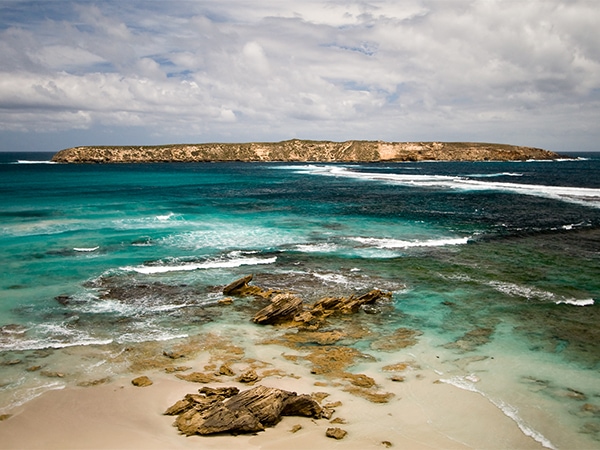
Have an adventure on the Eyre Peninsula.
The mighty Murray River is the longest in Australia, weaving its way through three states – NSW, Victoria and South Australia. Concentrating on the stretch running from Albury in NSW to Echuca in Victoria in the Murray Valley food bowl – one of the country’s most productive agricultural areas – offers up the perfect bite-sized (literally) road trip, filled with scenery, food and passionate locals.
Start the journey from Albury and aim to cover the roughly 227 kilometres to make it to the border town of Moama by late afternoon. The first stop worth making along the way is in Corowa, a quick 45 minutes from Albury. The drawcard here is Corowa Whisky & Chocolate. You can sample its whiskies in the cosy tasting room, but designated drivers would be best sticking to the thick, sweet hot chocolate in the cafe instead.
It’s another 45 minutes’ drive to the town of Yarrawonga, stop here to shop the award-winning olive oils, gourmet foods and beauty products at the family-owned Rich Glen Olive Estate’s on-site store and cafe.
Continue on to Moama and head to Perricoota Vines Retreat, an award-winning lakeside village populated by comfortable self-catering villas and some excellent leisure facilities, which is the perfect base for the next few days given its handy proximity to sights and sustenance.
After breakfast in your villa head out on foot to St Anne’s Winery (an easy 15-minute walk) for the daily tastings conducted at the rammed-earth cellar door. The property produces a range of wines, from light whites and full-bodied reds to rich, sticky muscats.
You can work off your late-morning tipple by walking another 15 minutes towards town for lunch at Three Black Sheep. A popular breakfast and lunch spot with locals, the menu is made up of eclectic cafe fare and the servings are generous (and delicious).
With lunch done, grab a coffee to go and head back towards Perricoota Vines Retreat, and keep walking another 10 minutes past it to arrive at Pacdon Park, purveyors of all things pork. Find pork pies, pork sausages, streaky bacon, black pudding, white pudding, gammon steaks and haggis (buy up big while you are here and that’s dinner taken care of) .
On the return trip back to Albury break up the journey at Lake Mulwala and stay for a meal at Blacksmith Provedore, a stylish restaurant and bar that trades on the feels of summer holidays of old, while hinting at the future direction for the town.
Back in Albury, head to Circa 1928 for the night (a boutique spa hotel housed in a former Art Deco bank building close to the town’s botanic gardens and Murray Art Museum Albury before returning home the next day with a bagful of local produce from this most delicious of bite-sized road trips.
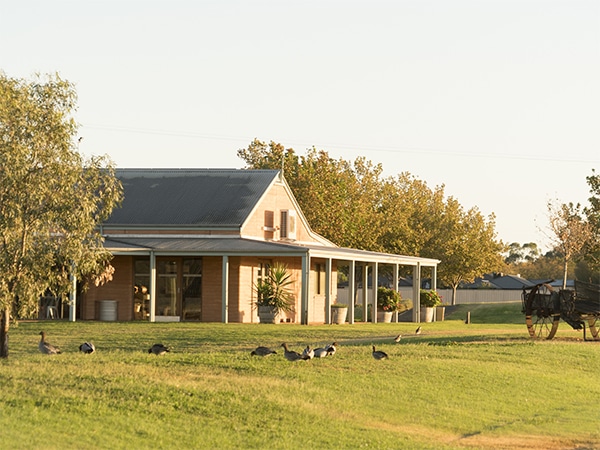
Eat your way around the Murray River Valley (Credit St Anne’s Winery).
LEAVE YOUR COMMENT